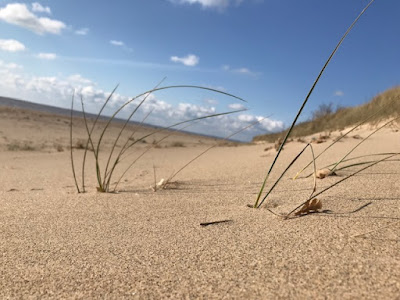I made a trip back to God's own country last week. East Yorkshire.
It's where I grew up, and my parents still live there. Taking the kids for a few days I decided to grab a day to myself and visit Spurn Point. I used to go there a fair bit as a kid and then into my twenties but have only been a few times in the last couple of decades. I certainly haven't visited since the infamous Yorkshire Wildlife Trust Visitor Centre was built.
Getting there always seem a bit like going back in time. Going through Thorngumbald, Patrington and Eastington, these villages haven't really changed much in the 35 years I've been passing through.
And that's always been the attraction of visiting Spurn: it's like visiting the edge of the world, in the 1970s!
I arrived and parked just before nine and decided to walk point-wards. A few years ago the decision was made to stop protecting the sand spit that is Spurn and very quickly the sea breached the middle part. The system has always been dynamic, it's just that people naively thought that they could prevent mother nature's wishes.
Walking across the breached part I noticed something in the sand: a dead porpoise. I decided to check it for beetles but soon forgot to breathe through my mouth and was assaulted by Beelzebub in nasal form. I crawled away on hands and knees, gagging and retching with no beetles as reward.
Getting back amongst the sea buckthorn, Browntail moth caterpillars were everywhere. On the ground and spinning their silken capsules in seemingly every bush.
The sun was out and the Point looked stunning. It was cold in the wind but nestled amongst the dunes it was almost balmy.
I found a quite spot to look at some plants. I soon realised that I'm pretty shit at plant ID and that's being generous.
I picked one plant that I thought was obviously in the cabbage family and then spent ages trying to work out what it was. I think it's Shepherd's Cress
Teesdalia nudicaulis but am happy to be corrected.
I then had a look at this tiny thing. Still not sure.
I really think I need to make more of an effort with green things!!
It was nice to see a flock of Brent Geese feeding on eel grass before they head a long way north to breed on Arctic Tundra. Also a fair few Curlew gave themselves away from their bubbling calls out on the mud.
A couple of the nicer insects included a Bordered Shieldbug
Legnotus limbosus and a 24-spot Ladybird
Subcoccinella vigintiquatuorpunctata with an almost black pronotum.
I made it to the Point then turned tail and headed back the way I had come. It really was a beautiful day.
And what of the infamous Visitor centre? Well it's perfectly fine and I had a decent coffee, but it has brought a bit of the 21st Century to Spurn and I'm not sure that's a good thing...





















